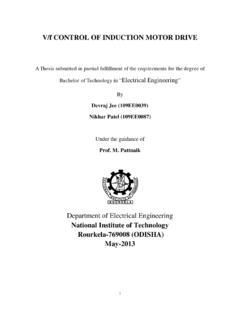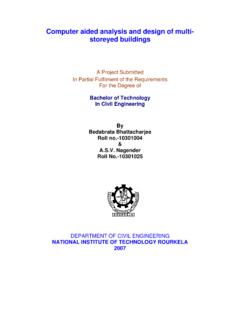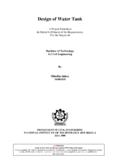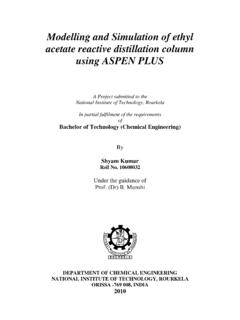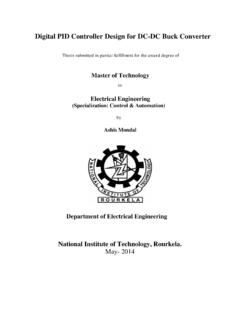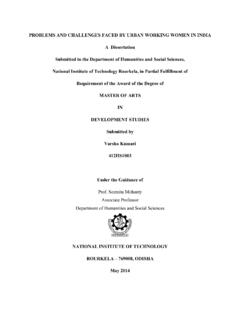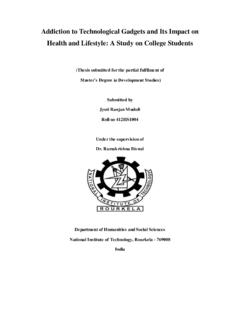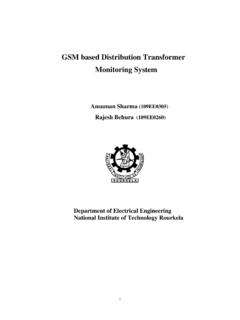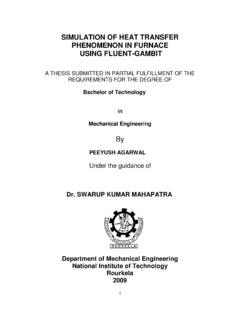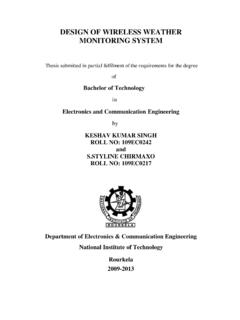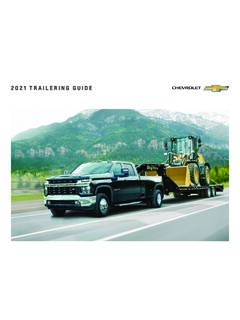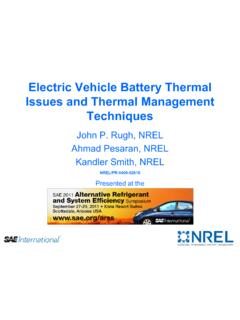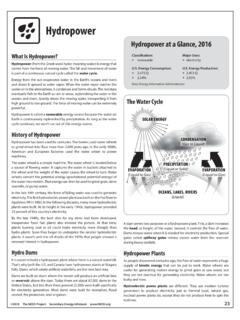Transcription of DESIGN OF A HYBRID ELECTRIC VEHICLE - nitrkl.ac.in
1 DESIGN OF A HYBRID ELECTRIC VEHICLE TOSHALI MOHANTY (109EE0286) Department of Electrical Engineering National Institute of Technology Rourkela - 2 - DESIGN OF A HYBRID ELECTRIC VEHICLE A Thesis submitted in partial fulfillment of the requirements for the degree of Bachelor of Technology in Electrical Engineering By TOSHALI MOHANTY Under guidance of Prof. BIDYADHAR SUBUDHI Department of Electrical Engineering National Institute of Technology Rourkela-769008 (ODISHA) May-2013 - 3 - DEPARTMENT OF ELECTRICAL ENGINEERING NATIONAL INSTITUTE OF TECHNOLOGY, ROURKELA ODISHA, INDIA-769008 CERTIFICATE This is to certify that the thesis entitled DESIGN of a HYBRID ELECTRIC VEHICLE , submitted by Toshali Mohanty (Roll.)
2 No. 109EE0286) in partial fulfilment of the requirements for the award of Bachelor of Technology in Electrical Engineering during session 2012-2013 at National Institute of Technology, Rourkela. A bonafide record of research work carried out by them under my supervision and guidance. The candidates have fulfilled all the prescribed requirements. The Thesis which is based on candidates own work, have not submitted elsewhere for a degree/diploma. In my opinion, the thesis is of standard required for the award of a bachelor of technology degree in Electrical Engineering. Place: Rourkela Dept. of Electrical Engineering Bidyadhar Subudhi National institute of Technology Professor Rourkela-769008a ACKNOWLEDGEMENTS I wish to express my sincere gratitude to PROF.
3 S. K. SARANGI, Director and Prof. A. K. PANDA, of Electrical Engineering Department of National Institute of Technology, Rourkela for providing me an opportunity to do my project work on DESIGN OF A HYBRID ELECTRIC VEHICLE . This project bears on imprint of many peoples. I sincerely thank to my project guide Prof. Bidyadhar Subudhi, Department of Electrical Engineering, National Institute of Technology, Rourkela for his able guidance and constant encouragement in carrying out this project work. Last but not least I wish to avail myself of this opportunity, express a sense of gratitude and love to my friends for their manual support, strength, help and for everything.
4 B Dedicated to My parents i ABSTRACT A 'gasoline- ELECTRIC HYBRID car' or ' HYBRID ELECTRIC VEHICLE ' is a VEHICLE which relies not only on batteries but also on an internal combustion engine which drives a generator to provide the electricity and may also drive a wheel. It has great advantages over the previously used gasoline engine that drives the power from gasoline only. It also is a major source of air pollution. The objective is to DESIGN and fabricate a two wheeler HYBRID ELECTRIC VEHICLE powered by both battery and gasoline. The combination of both the power makes the VEHICLE dynamic in nature.
5 It provides its owner with advantages in fuel economy and environmental impact over conventional automobiles. HYBRID ELECTRIC vehicles combine an ELECTRIC motor, battery and power system with an internal combustion engine to achieve better fuel economy and reduce toxic emissions. In HEV, the battery alone provides power for low-speed driving conditions where internal combustion engines are least efficient. In accelerating, long highways, or hill climbing the ELECTRIC motor provides additional power to assist the engine. This allows a smaller, more efficient engine to be used.
6 Besides it also utilizes the concept of regenerative braking for optimized utilization of energy. Energy dissipated during braking in HEV is used in charging battery. Thus the VEHICLE is best suited for the growing urban areas with high traffic. Initially the designing of the VEHICLE in CAD, simulations of inverter and other models are done. Equipment and their cost analysis are done. It deals with the fabrication of the VEHICLE . This includes assembly of IC Engine and its components. The next phase consists of implementing the ELECTRIC power drive and designing the controllers.
7 The final stage would consist of increasing the efficiency of the VEHICLE in economic ways. ii CONTENTS Abstract i Contents ii List of Figures iv List of Tables vi Abbreviations and Acronyms vi CHAPTER 1 INTRODUCTION Motivation 1 Concept of HEV 1 Basic DESIGN of HEV 2 Advantages of HEV 2 Claims for the project Overview Of Proposed Work done 3 Thesis Objectives 3 Organization of Thesis 4 CHAPTER 2 HYBRID ELECTRIC VEHICLE Introduction 7 CAD Model of HEV
8 7 Components 11 Description of the diagrams 11 Block diagram of HEV 13 Working of HEV 13 iii CHAPTER-3 ELECTRIC BASED FRONT WHEEL DRIVE AND ITS COMPONENTS Introduction 16 MATLAB Circuit diagram 16 Components of ELECTRIC VEHICLE 17 Battery 17 Three phase inverter 20 Advantages of PWM VSI 21 BLDC Motor
9 21 CHAPTER-4 GASOLINE BASED REAR WHEEL DRIVE AND ITS COMPONENTS Gasoline Engine 23 Carburetion 23 CAD Model of IC Engine 24 CHAPTER-5 EFFICIENCY OF POWER DRIVES Introduction 26 Indicated Thermal Efficiency 26 iv Brake Thermal Efficiency 26 Mechanical Efficiency 26 Specific Fuel Cosumption 26 Efficiency of ELECTRIC drive 27 CHAPTER-6 EXPERIMENTAL RESULT Analysis 29 CHAPTER-7 CONCLUSION Conclusion 35 Contribution of the project 35
10 Future work 35 References 37 Appendix a) Equipments used to DESIGN the VEHICLE 39 LIST OF FIGURES Fig. No Name of the Figure Page. No. Schematics of HEV 2 Rendered View 7 Rear Rendered View 8 Side Rendered View 8 Front Rendered View 9 Transparent Body Frame Isometric view 9 v Transparent Body Frame Isometric view 10 Wire Frame Model Side View 10 Block diagram of HEV 12
